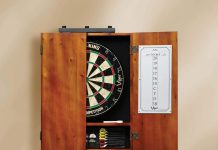Let’s talk darts. We all know that finding the right set of darts is essential for a great game, but have you ever wondered what the best material for darts actually is? From steel to tungsten to brass, there are numerous options out there, each with its own unique properties. In this article, we’ll explore the advantages and disadvantages of different dart materials, helping you make an informed decision the next time you step up to the oche. So, whether you’re a professional player or just enjoy a friendly game at the local pub, read on to discover which dart material suits your style and enhances your performance.
Review contents
Factors to Consider When Choosing a Dart Material
When it comes to selecting the perfect dart material, there are several factors that we need to take into consideration. These factors include weight distribution, grip, durability, and price. Each of these factors plays a significant role in determining the overall quality and performance of the darts. By understanding these factors, we can make an informed decision and choose the dart material that suits our preferences and needs the best.
Weight Distribution
Weight distribution is an essential aspect to consider when selecting a dart material. The weight distribution refers to how the weight is distributed along the length of the dart. It affects the stability and trajectory of the dart during flight. Different materials have varying weight distributions, and it’s important to find a weight distribution that feels comfortable and controllable for us.
Grip
The grip is another crucial factor to consider when choosing a dart material. The grip refers to the texture or pattern on the dart’s surface, which allows us to hold and throw the dart securely. A good grip ensures that the dart doesn’t slip from our fingers during the throw, providing us with better control and accuracy. The grip of a dart can vary depending on the material used, and it is essential to choose a material that offers a grip that suits our throwing style.
Durability
Durability is an important consideration when selecting a dart material, as we want our darts to withstand repeated use without easily wearing out or breaking. Different materials have different levels of durability, and it’s crucial to choose a material that is long-lasting and can withstand the rigors of regular play. Darts made from high-quality materials tend to be more durable and can withstand the impact of hitting the dartboard repeatedly.
Price
Price is an important factor to consider when choosing a dart material, as it directly affects our budget and the overall value we get from the darts. Different materials have varying price ranges, and it’s important to find a balance between quality and affordability. While some materials may be more expensive, they may offer better performance and longevity, making them a worthwhile investment. However, it is also possible to find darts made from more affordable materials that still offer good quality and performance.
Steel Tip Darts
Steel tip darts are a popular choice among professional dart players and enthusiasts alike. They are commonly used for playing the traditional game of darts, where the darts are thrown at a dartboard with steel tips. Steel tip darts can be made from various materials, each offering its own advantages and disadvantages.
Materials used for Steel Tip Darts
Steel tip darts can be made from a range of materials, including brass, tungsten, nickel/silver alloy, copper, composite, and even plastic. Each material has its own unique properties and characteristics, which directly affect the performance and feel of the darts.
Advantages of Steel Tip Darts
Steel tip darts offer several advantages that make them a popular choice among players. First and foremost, they provide excellent durability, making them suitable for frequent and intense use. Additionally, steel tip darts offer a good weight distribution, allowing for better accuracy and control during throws. They also tend to have a wide variety of designs and styles available, catering to different preferences and playing styles. Lastly, steel tip darts are commonly used in professional settings, making it easier to find tournaments and competitions to participate in.
Disadvantages of Steel Tip Darts
Despite their many advantages, steel tip darts also have a few drawbacks. The tips can wear down over time, requiring regular replacement. Additionally, steel tip darts may be more prone to bouncing out of the dartboard due to their increased weight compared to soft tip darts. Furthermore, the sharp steel tips can be a safety concern, especially when playing with young or inexperienced players. Lastly, steel tip darts tend to be more expensive compared to other types of darts, due to the materials used and the demand for professional-grade equipment.
Brass Darts
Brass darts are a common and budget-friendly choice for dart players who are looking for affordable yet reliable options. They are typically made from a brass alloy, which offers its own set of advantages and disadvantages.
Advantages of Brass Darts
One of the main advantages of brass darts is their affordability. They are often cheaper compared to other materials used for darts, making them an attractive option for beginners or casual players. Additionally, brass darts offer good weight distribution, allowing for better control and accuracy during throws. They also tend to have a moderately good grip, making them suitable for players who prefer a slightly smoother surface.
Disadvantages of Brass Darts
Despite their affordability, brass darts have a few disadvantages that should be considered. The main drawback of brass darts is their durability. They may wear down more quickly compared to darts made from other materials, such as tungsten or composite. Brass darts are also more prone to tarnishing or corroding over time, especially when exposed to moisture or excessive use. Lastly, brass darts may not provide the same level of performance or precision as higher-end materials like tungsten, which is something to consider for more serious players.
Tungsten Darts
Tungsten darts are considered by many to be the top-of-the-line choice for serious dart players. Tungsten is a dense and heavy metal that offers several advantages for those looking for high-performance darts.
Advantages of Tungsten Darts
One of the main advantages of tungsten darts is their high density, which allows for a slimmer barrel design. The slimmer barrel enables darts to be grouped closer together on the dartboard, increasing the chances of achieving high scores. Tungsten darts also offer excellent durability, as they are resistant to wear and corrosion. Additionally, the weight distribution of tungsten darts is typically excellent, providing unparalleled control and accuracy during throws. Finally, tungsten darts are often favored by professional players, making them a popular choice for serious dart enthusiasts.
Disadvantages of Tungsten Darts
While tungsten darts offer significant advantages, they do come with a few drawbacks. The main downside is their high price, as tungsten is a premium material that demands a higher cost. This makes tungsten darts less accessible to beginners or players on a tight budget. Additionally, tungsten darts may have a more aggressive grip, which may not be suitable for players who prefer a smoother or less abrasive surface. Finally, tungsten darts can be quite dense and heavy, which may not be comfortable for players who prefer lighter darts.
Nickel/Silver Alloy Darts
Nickel/silver alloy darts are another popular choice among dart players. The alloy is a combination of nickel and silver, offering a unique set of properties that make it a popular choice.
Advantages of Nickel/Silver Alloy Darts
Nickel/silver alloy darts offer a good balance of affordability and performance. They are generally more affordable compared to tungsten darts, making them a suitable choice for players on a budget. These darts also tend to have a comfortable grip, providing a secure and controlled throw. Additionally, nickel/silver alloy darts offer decent weight distribution, contributing to better accuracy during play. Lastly, these darts are relatively durable and can withstand regular use without easily wearing out.
Disadvantages of Nickel/Silver Alloy Darts
One of the main disadvantages of nickel/silver alloy darts is their longevity. While they are generally durable, they may not last as long as darts made from tungsten or other high-quality materials. The tips of nickel/silver alloy darts may also be more prone to breakage or bending, requiring regular replacements. Additionally, these darts may not provide the same level of precision or performance as more premium materials. However, for recreational or casual players, the disadvantages may not be as prominent.
Copper Darts
Copper darts are a less common choice compared to other materials, but they still offer their own unique advantages for certain players.
Advantages of Copper Darts
Copper darts are known for their excellent grip. The natural properties of copper provide a slightly rough surface, which enhances grip and ensures that the dart stays securely in hand during the throw. Additionally, copper darts are usually quite affordable, making them a suitable option for players on a budget. The weight distribution of copper darts is generally good, allowing for better control and accuracy. Finally, copper darts tend to have a distinctive aesthetic appeal, making them an attractive choice for players seeking a unique look.
Disadvantages of Copper Darts
Despite their advantages, copper darts do have a few disadvantages. The main drawback is their durability. Copper is a softer metal compared to materials like tungsten, brass, or composite, and it can easily wear down or deform over time. The softness of copper may also make the dart more susceptible to bouncing out of the dartboard, reducing the chances of scoring points. Additionally, copper darts may oxidize or tarnish more quickly, requiring regular maintenance to keep them in good condition.
Composite Darts
Composite darts are made from a combination of different materials, creating a unique blend that offers a balance of performance and affordability.
Advantages of Composite Darts
Composite darts provide a good middle ground for players who want a reliable dart without breaking the bank. They are often more affordable compared to premium materials like tungsten darts. Composite darts also offer a decent grip, allowing for better control during throws. The weight distribution of composite darts is typically balanced, providing a comfortable and stable feel. Additionally, composite darts tend to have good durability, making them suitable for regular play.
Disadvantages of Composite Darts
While composite darts have their merits, they also have a few disadvantages. The main drawback is that they may not offer the same level of precision or performance as higher-end materials like tungsten. The grip of composite darts can vary depending on the specific blend of materials used, which may not suit all players’ preferences. Additionally, composite darts may wear down or deform over time, albeit at a slower rate compared to softer materials like copper.
Plastic Darts
Plastic darts are a popular choice for beginners, recreational players, or those who prefer a softer dart that is less likely to cause damage or injury.
Advantages of Plastic Darts
One of the main advantages of plastic darts is their affordability. They are often the most budget-friendly option available, making them accessible to a wide range of players. Plastic darts also offer a comfortable grip, as the material is less abrasive compared to metals or composites. Additionally, plastic darts are lightweight, making them easier to handle, especially for players who prefer a lighter dart. They are also less likely to cause damage to walls or surrounding objects in case of an accidental throw off target.
Disadvantages of Plastic Darts
Despite their affordability and convenience, plastic darts have a few downsides. The main disadvantage is their durability. Plastic darts are prone to breaking or cracking, especially if they are subjected to rough handling or high impact. The lightweight nature of plastic darts may also affect their accuracy and stability during flight, making them less suitable for precision-focused players. Additionally, some players may find that plastic darts lack the same overall feel and performance as darts made from other materials.
Soft Tip Darts
Soft tip darts are commonly used for electronic dartboards, where the darts have plastic tips that are designed to stick into the soft surface of the board. They offer a different playing experience compared to steel tip darts.
Advantages of Soft Tip Darts
One of the main advantages of soft tip darts is their increased safety. The soft tips greatly reduce the risk of injury, making them suitable for all ages and skill levels. Soft tip darts also offer more forgiveness when it comes to bouncing out of the dartboard, as the tips are less likely to cause damage to the board or surrounding area. Additionally, soft tip darts often come with a wider variety of electronic dartboard games, adding to the overall fun and entertainment factor.
Disadvantages of Soft Tip Darts
Despite their advantages, soft tip darts also have a few disadvantages. The main drawback is their limited use, as they are typically only suitable for electronic dartboards. Soft tip darts may also have a different feel and weight distribution compared to steel tip darts, requiring some adjustment for players switching between the two. Additionally, the plastic tips of soft tip darts may wear down more quickly and may require regular replacement.
Conclusion
Choosing the right dart material is a personal preference and depends on various factors such as weight distribution, grip, durability, and price. Steel tip darts made from materials like brass, tungsten, nickel/silver alloy, copper, composite, or plastic each have their own advantages and disadvantages. Brass darts offer affordability but may lack in durability. Tungsten darts provide excellent performance but come with a higher price tag. Nickel/silver alloy darts offer a good balance between affordability and performance. Copper darts provide a unique grip but may be less durable. Composite darts offer a middle ground for budget-conscious players. Plastic darts are lightweight and affordable but may lack durability. Soft tip darts are safe and suited for electronic dartboards. It is important to consider these factors carefully and choose a dart material that suits our preferences and needs.























![Best Outdoor Dartboards [Reviews and Buying Guide 2024] Best Outdoor Dartboards](https://gamersets.com/wp-content/uploads/2022/12/Best-Outdoor-Dartboards-100x70.jpg)

![Best Mini Air Hockey Table [Reviews & Buying Guide 2024] Best mini air hockey table](https://gamersets.com/wp-content/uploads/2022/10/Best-mini-air-hockey-table-100x70.jpg)







